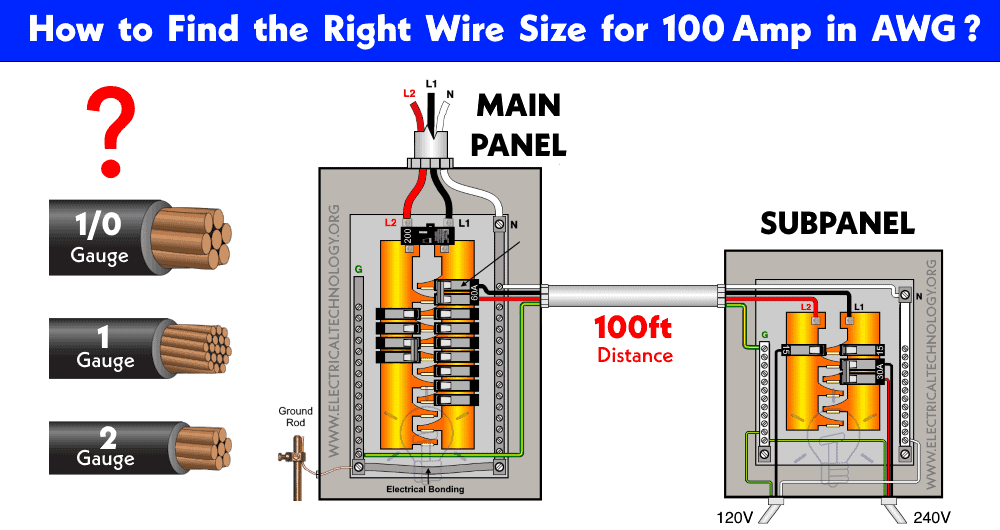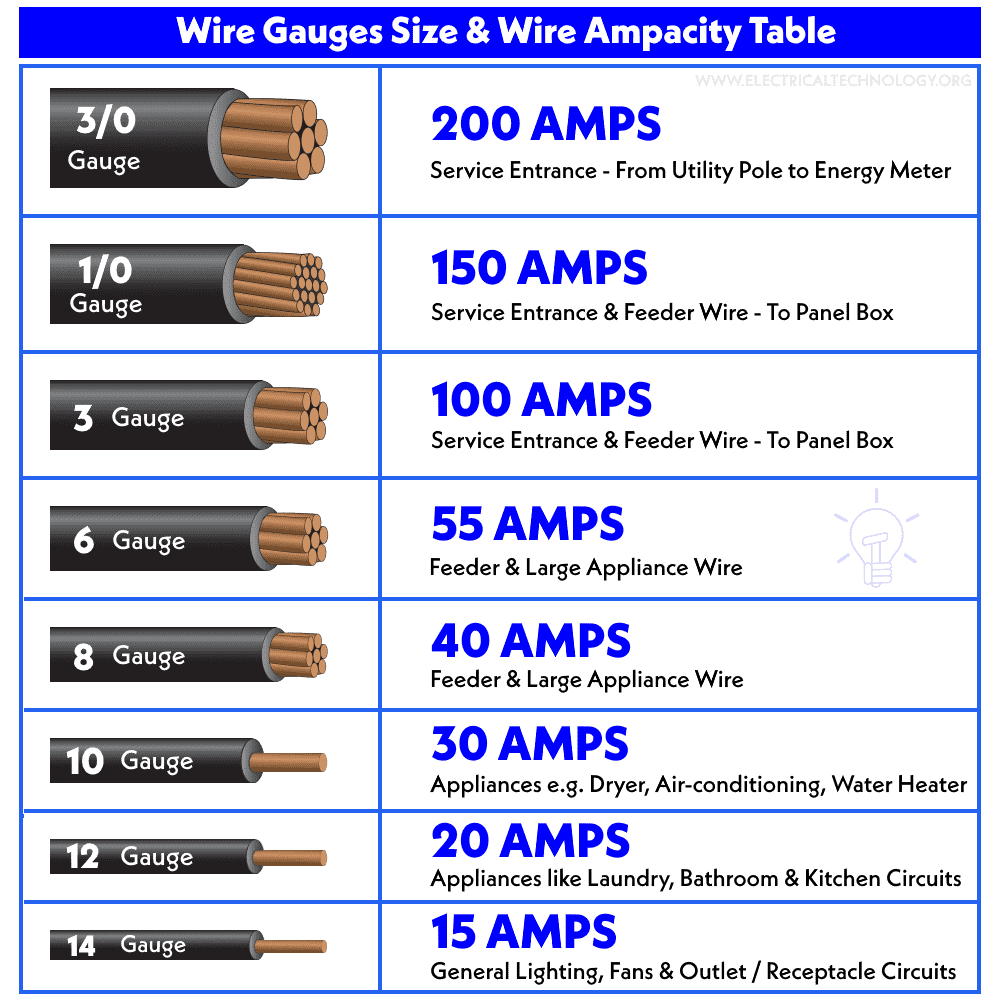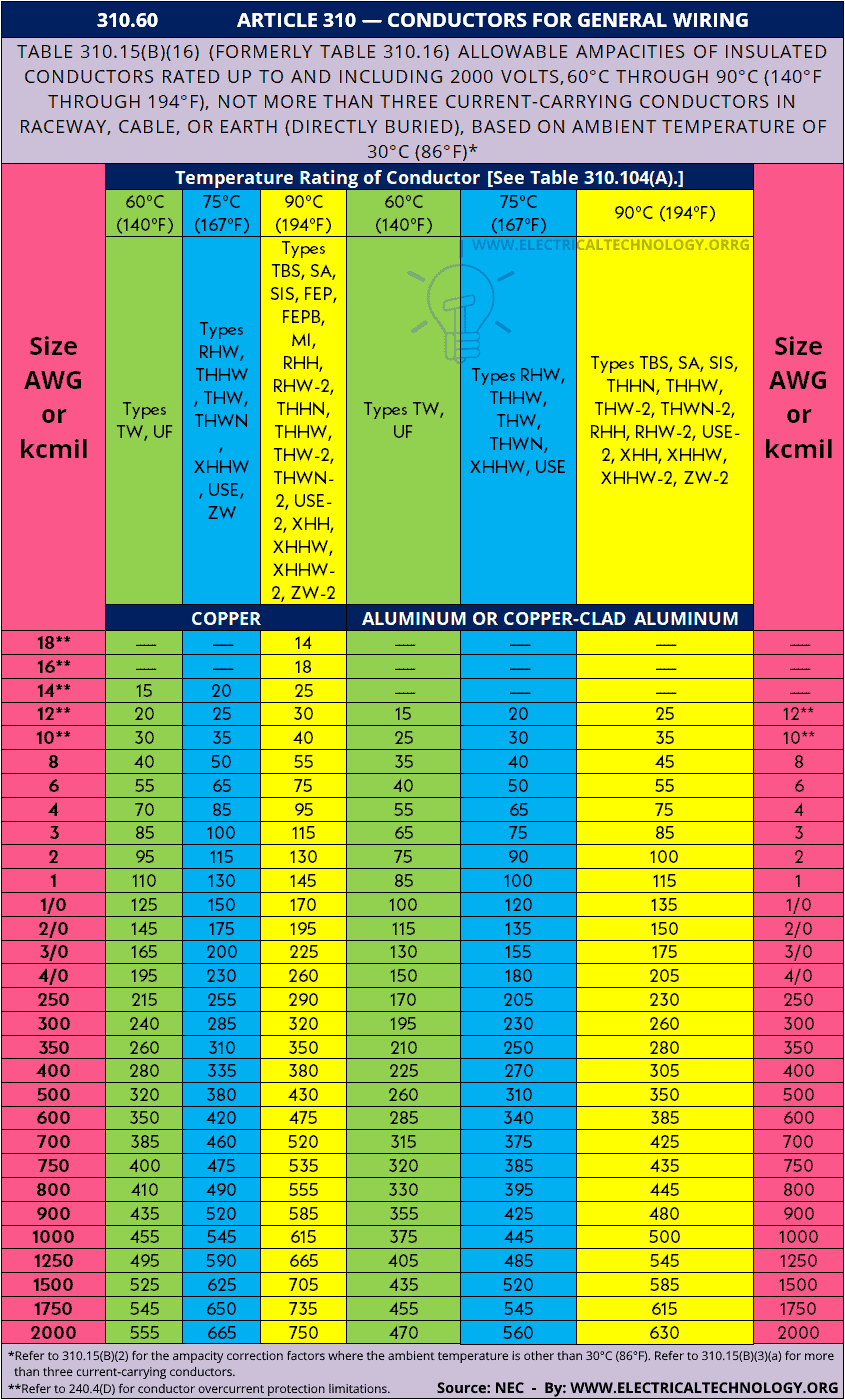What Size Wire is Needed for a 100-Amp Subpanel Running 80 to 100 Feet to a 100-Amp Breaker?
The proper wire size for a 100-amp load circuit (e.g., a subpanel) depends on several factors, including the distance between the main panel and the load circuit (i.e., subpanel), as voltage drop over the length of the run is a significant consideration.
Other factors affecting wire size include voltage (120V or 240V), ambient temperature, the number of wires in a bundle, and the type of wiring used. Let’s go through the necessary electrical calculations to determine the correct wire size for a 100A circuit, considering both ideal and real-world scenarios.
Related Posts:
- How to Determine the Right Size Capacity of a Subpanel?
- How to Wire a Subpanel? Main Lug Installation for 120V/240V
In the US, a 25kVA, 7200V/240V distribution transformer provides electric power at 100 amps as follows:
- Power = 240V × 100A = 24,000 Watts
Based on this, the ideal wire size for a 100-amp breaker is #1 AWG for copper and #1/0 AWG for aluminum, according to the AWG size chart and NEC Table 310-15B (formerly 310-16) Article 310.60 (below).
As it may applicable for 100A load circuits, however, this may not be suitable when considering distance and demand factor for main or subpanels, as it could lead to significant voltage drops. To address this, we will perform more detailed calculations based on NEC codes and related tables to determine the correct wire size for a 100-amp circuit over a distance of 100 feet.
Hence, the suggested wire size for a 100-amp service is #4 AWG for copper and #2 AWG for aluminum, according NEC Table 310-12(A).
Good to know: The required wire size for 100A services is smaller than a 100A dedicated circuit.
Factors Affecting the 100A Wire Size
NEC (National Electric Code) guidelines for 100A wire size:
- 100-Amp Circuit Usage: NEC 210.19 for continuous load circuits states that a 100-amp circuit should operate at 80% of its rated load. This means using a 125% rated breaker for load current, a minimum 100-amp breaker, for an 80-amp continuous load circuit. Similarly, the demand factor involves when selecting the wire size for 100A main or subpanel.
- Voltage Drop: Add 20% additional ampacity for every 100 feet to counter voltage drop in long-distance runs (over 50 feet or 15.25 meters) – NEC 310-16.
- Demand Factor: Consider a 35% demand factor for general lighting in load centers and main panels (NEC 220.45).
- Temperature Rating: The ampacity (current-carrying capacity) of the wire depends on the temperature rating of the wire’s insulation.
- Wire Insulation Type: Different insulation types of cables include THHN/THWN, SE (Service Entrance) Cable, SER, XHHW-2, UF-B, MC (Metal Clad) Cable, RHH/RHW-2, Direct-Burial Cable are used with 100A circuit based on the requirements
Good to Know: All calculations are based on a median temperature of 167°F (75°C). Wire sizes may vary with temperature. Refer to the wire chart and tables for different ambient temperatures and their ampacities.
Correct Wire Size for 100-Amp Subpanel at 100ft
The required wire size in AWG for a 100A breaker in a main panel or subpanel is generally smaller than for a dedicated 100A breaker used with a specific circuit. This is because of the demand factor in the NEC which states all the load points are not operational simultaneously.
For example, the air conditioner runs during the summer while the heater is off, and the opposite occurs in the winter. Similarly, appliances like electric irons, stoves, hair dryers, light bulbs, washing machines, and TVs are rarely used all at once. Hence, less current flows in the circuit. On the other hand, a dedicated circuit may operate at full rated amperes.
For this reason, demand factor mentioned in the NEC 220.42 and 220.45 should be consider while sizing a main panel or selecting the wire size for a subpanel.
NEC 220.14 allows the use of 220.55 and Table 220.55 for calculating branch circuit loads for ranges. Be sure to reference Note 3 in Table 220.55 as well.
For non-continuous loads like water heaters and ranges, calculate the demand for one unit in Column B of Table 220.55 as 80% of the nameplate rating. For example, use 8 kW for calculations if the required load is 10 kW (80% of 10 kW).
In residential applications, calculate general resistive and lighting load circuits using a demand factor of 100% for the first 3 kVA and 35% for the remaining continuous load (as specified in 220.42 and 220.45)
Example:
What is the correct wire size for a 100A main or subpanel service entrance breaker having a distance of 100 ft (30.50 meters)?
Solution:
A 100A circuit can handle up to 24,000 watts of load on a 240V circuit. Applying the continuous, non-continuous, and demand factors. According to NEC Table 220.42 and 220.45, the first 3 kVA of load is rated at 100%, while the remaining load can be rated at a demand factor of 35%, specifically for general lighting loads.
- The first 3 kVA at 100% = 3 kW
- Remaining 24 kVA (24 kVA – 3 kVA) at 35% = 7.35 kW
3kW (at 100% of 24kW) + 7.35kW (at 35% of (24kW – 3kW)) = 10.35 kW
To calculate the current, use Ohm’s Law: I = P ÷ V
Current = 10.35 kW ÷ 240 V = 43.125 A
If the main panel or subpanel is more than 50 ft (15.25 m) away, the NEC recommends adding 20% ampacity for every 100 ft (30.50 m) to account for voltage drop:
43.125 A × 20% = 51.75
To add the safety factor of 80% load on the rated current, i.e. the breaker should be rated at 125%. In other words, no more than 80% of load should be connected to the rated OCPD device. Multiply 1.25 to the calculated value as:
The breaker for this load should be rated at 125%:
× 1.25 = 64.68 A
According to NEC 310.15(B)16, the suitable wire size for a 100A breaker in the main panel or subpanel is #4 AWG copper or #2 AWG aluminum having a distance of 100 feet (30.5 meter). The suitable ground wire size for 100-Amp service with main or subpanel is #8 AWG copper or #6 AWG aluminum.
Related Posts:
- What is the Right Wire Size for 15A Breaker and Outlet?
- What is the Suitable Wire Size for 20A Breaker and Outlet?
Good to Know:
- This calculation are based on the NEC guidelines. For more details, refer to NEC 210.19(A), 210.21, 210, 24, 215.2, 220.110, 220.14, 220.42, 220.45, 220.53, 220.55, 230.42(A), 240.4, 310.12, 310-14 and 517.22.
- The calculation is based on a 240V main panel or subpanel installation at a mean temperature of 75°C (167°F). In the case of a basic 120V panel and load circuits, change the value from 240V to 120V and find the wire size in AWG.
- The wire size is typically determined by the ampacity (current-carrying capacity) and the voltage drop. The National Electrical Code (NEC) provides guidelines for wire sizes and ampacities for copper and aluminum conductors.
- It is recommended to use copper wire over aluminum wire. While copper wire is more expensive, it is also more durable and has a higher ampacity than aluminum wire.
- Additionally, use THHN/THWN, SE, SER, XHHW-2, UF-B, MC or RHH/RHW-2 cables for these high power circuits. These types of insulation are designed for use in high-temperature and wet environments.
- Ensure to use the correct conduit size to accommodate the wires without overfilling it..
- Consider the number of wires in the bundle. If you are running multiple wires in the same conduit, you will need to use a larger wire size to compensate for the heat generated by the wires.
- Always consult with a licensed electrician for proper wiring installation to ensure compliance with local codes
Wire Size for 100-Amp Subpanel Based on NEC – 83% Rule
NEC 310.12 states that the ampacity of the service or feeder should not less than the 83% of its rated capacity. Table 310.12(A) in Section 310.12 shows the recommended wire sizes for service and feeder in single-phase dwelling units. Keep in mind that this rule is only applicable for the first service entrance coming in to a dwelling or where the subpanel is supplying power up to 400A to the entire load of a dwelling unit.
subpanel is supplying the entire load of a one family dwelling.
Example:
What is the correct Wire size for 100A Service/Feeder for a Main panel or subpanel provided supply to the entire dwelling unit?
Solution:
According to 83% rule in NEC 310-12:
100A x 83% = 83 A
Based on the NEC Table 310.12, the correct wire size for 100A service is #4 AWG Copper or #2 AWG Aluminum.
Good to Know:
- The recommended wire size for a 100A breaker and load circuit is #1 AWG copper or 1/0 AWG aluminum – NEC 310.15(B)(16).
- The suitable wire size for a 100A service is #4 AWG copper or #2 AWG aluminum – NEC Table 310.12(A
Wire Size for a 100A Load Circuit
Keep in mind that a 100A breaker in the panel and a 100A dedicated load circuit are different things and require different wire sizes. The total lighting load for the dwelling unit is used to size the feeder circuit that supplies the branch circuits. The NEC mandates that the ampacity of the feeder circuit must be sufficient to carry the total load of all the branch circuits connected to it.
100A Continuous Load
If your total calculated load, for example, is a 100A continuous load circuit, the NEC requires you to rate the OCPD (overcurrent protection device, such as a breaker) at 125% of the minimum wire ampacity for the power circuit. This means you should connect only 80% of the load to the rated fuse or breaker.
Therefore, the required breaker and wire size based on ampacity for a 100A dedicated continuous load circuit is as follows:
Wire Ampacity = 100 Amps × 1.25 = 125 Amps.
Required Wire Size: #1/0 AWG Copper (#3/0 AWG for Aluminum)
In other words, if your continuous load is 100A, you should select a 125A breaker for this dedicated circuit, with #1/0 AWG copper or #3/0 AWG aluminum wire.
100A Non-continuous Load
For a 100A non-continuous load circuit, you can use a 100A breaker, and the appropriate wire size would be #1 AWG copper or 1/0 AWG aluminum, both of which are sufficient for this application.
Good to Know:
- A 100A dedicated circuit requires a larger wire size than the 100A breaker in the main or subpanel.
- A 100A service for a main or subpanel needs #4 AWG copper or #2 AWG aluminum.
- A 100A dedicated circuit requires #1 AWG copper or 1/0 AWG aluminum.
- A 100A continuous load needs #1/0 AWG copper or #3/0 AWG aluminum.
- Use a 100A breaker for a maximum of 80A continuous load circuit.
AWG Table and Chart:
Click image or open in a new tab to enlarge
Resources:
- How to Size a Load Center, Panelboards and Distribution Board?
- How to Determine the Number of Circuit Breakers in a Panelboard?
- How to Find the Proper Size of Circuit Breaker? Breaker Size Calculator & Examples
- How to Find The Suitable Size of Cable & Wire for Electrical Wiring Installation? (Metric & Imperial Systems)
- How to Find Voltage & Ampere Rating of Switch, Plug, Outlet & Receptacle
- American Wire Gauge “AWG” Chart – Wire Size & Ampacity Table
- American Wire Gauge “AWG” Calculator – AWG Size Chart & Table
- Standard Wire Gauge “SWG” Calculator – SWG Size Chart & Table
- AWG/SWG to mm/mm2, inch/inch2 & kcmil Calculator & Conversion
- How to Wire 120V & 240V Main Panel? Breaker Box Installation
- How to Wire a Garage Consumer Unit?
- Wire and Cable Size Calculator in AWG
- Electrical Wire and Cable Size Calculator (Copper & Aluminum)




 Difference Between GND, 0VDC, Common and Virtual Ground
Difference Between GND, 0VDC, Common and Virtual Ground Is It Dangerous to Carry a Battery in an Elevator?
Is It Dangerous to Carry a Battery in an Elevator? What is the Difference Between AC Ground and DC Ground?
What is the Difference Between AC Ground and DC Ground? Should You Connect GND and 0VDC? Combined AC & DC Grounding
Should You Connect GND and 0VDC? Combined AC & DC Grounding Can you Combine AC and DC Ground in a Solar Installation?
Can you Combine AC and DC Ground in a Solar Installation? Why Doesn’t DC System Require a Grounding System Similar to AC System?
Why Doesn’t DC System Require a Grounding System Similar to AC System?